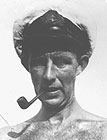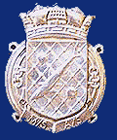


 |
 |
 |
|
In the Autumn of 1943 all ships of the 27th A/S M/S were withdrawn from convoy duty and sent into Rosyth/Granton for a major refit which took some 6 weeks. Amongst other modifications it included the taking out of the mizzen mast which would interfere with the twin .5mm guns to be installed. When
personnel returned to the ship, on completion of the refit, we all felt
something big, involving the ship was on hand but had not any idea of
what it was to be. However we were all disappointed to find all ships
plus H.M.T. Arab, one of the largest commercial trawlers requisitioned
by Admiralty had been fitted out, for service in some cold northern
water i.e. the North Atlantic where we had already been serving |
|
|
|
When personnel returned to the ship, on completion of the refit, we all felt something big, involving the ship was on hand but had not any idea of what it was to be. However we were all disappointed to find all ships plus H.M.T. Arab, one of the largest commercial trawlers requisitioned by Admiralty had been fitted out, for service in some cold northern water i.e. the North Atlantic where we had already been serving. However when the time came to say good-bye to wives and sweethearts, we discovered we were bound for escort duties down to the Mediterranean i.e. landings planned in North Africa. In consequence we suffered from lack of refrigeration so much so that when H.M.T. Arab, referred to previously, got to Algiers with the North Africa landings, she was unable to go to sea because of the intense heat in the engine room. She lay there, sweltering in harbour, for some 3 weeks whilst cooling equipment was sent out from the UK. After the war I discovered that the reason for fitting out the ships, as for cold northern climes, was because Rosyth, Edinburgh and Granton, where the refitting was done, was a hotbed of spies. In consequence information had been passed to German High Command, to expect an invasion in Northern Norway. At the time of the Africa landings Hitler had his strongest naval and airforce troops in North Norway - so the attempt at deception by our "Powers that be" had worked. On disposing of our convoy of 40 ships at Gibraltar (prior to N.A. Landings) we had to coal ship. This had to be done by hand of officers and crew as there was no mechanical equipment there. I should think this flotilla of ships much had been the last coal burners to be built. To load up 200 tons of coal, by hand and basket, took a long time and was not a pleasant task. Once a landing in North Africa was established, and as the German Army were driven East, H.M.S. Twostep was transferred, with all other ships of the 27th A/S M/S Group to Bougie (North Africa). It was at Bougie that C W C Med requested us "to give a lift" to Sub Lt Wilbraham on passage to Sydney Australia. We were to discharge him to the RN Base at Alexandria whenever we next got there! It transpires that Sub Lt Wilbraham of the Royal Australian Naval Volunteer Reserve, who lived in Sydney, Australia, had been drafted by the Australian Navy to join H.M.S. Newcastle fitting out at Newcastle. In consequence he had been sent across the Pacific to America, across the Atlantic to report at Admiralty in London. To his surprise. Admiralty stated there was no such ship fitting out in Newcastle and a mistake had occurred in his drafting orders. The Newcastle referred to in his draft was the Port of Newcastle in Australia about 70 miles north of his starting point Sydney.. (The writer is not certain that the name of the ship was Newcastle and cannot verify because Sub Lt Wilbraham died some years ago) in Australia. H.M.S. Twostep carried out escort duties from Gibraltar along the North African Coast as far as Alexandria calling often at Malta. The ship, ships officers and crew all qualified for the Malta George Cross Fiftieth Anniversary Medal in appreciation for their work in the relief of the Siege of Malta. H.M.S. Twostep was involved in the landings on Sicily, Salerno and Anzio and was based in Naples mainly doing convoy escort duties up the West coast of Italy. H.M.S. Twosteps experiences in the Mediterranean are already described in any excellent articles chiefly by Lieutenant Bryan Cambray and these will not therefore be repeated here. On 16th December 1944 - literally only days before H.M.S. Twostep took part in the Battle of Mesco Point so well already written up (see RNPS fight back) , I was appointed to take Command of H.M.S. Foula as Senior Officer Daulayers to the 12th Minesweeping Flotilla, then based on Alexandria and so ended my happy years on Tarantella/Twostep thanks to a superb set of Officers and crew. |
 |
 |